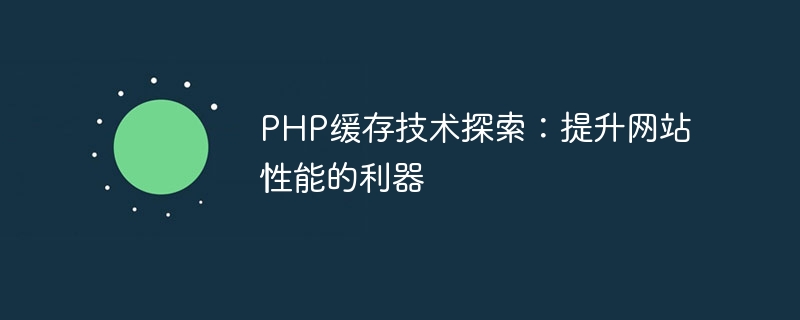
PHP缓存技术探索:提升网站性能的利器,需要具体代码示例
引言:
在当今互联网的高速发展下,网站性能对于用户体验和搜索引擎排名至关重要。而PHP作为一种常用的编程语言于网站开发中广泛应用,如何提升PHP网站的性能成为了开发者们迫切探索的问题。其中一个非常重要的解决方案就是利用PHP缓存技术,本文将对PHP缓存的概念和具体技术进行探索,并附带代码示例,帮助读者理解和应用这些技术来提升网站性能。
一、什么是PHP缓存
PHP缓存是指将PHP脚本的中间结果缓存起来,避免每次请求都去重新解析和执行PHP脚本。这种缓存的机制可以大大提升网站的性能,减少服务器的负载,提高用户的访问速度。PHP缓存可分为两种类型:页面缓存和数据缓存。
1.1 页面缓存
页面缓存是指将服务器返回的页面内容进行缓存,以便下一次请求时直接返回已缓存的页面,而无需重新生成。常见的页面缓存方案有:静态页面缓存、动态页面缓存和片段缓存。其中,静态页面缓存是将页面的HTML内容缓存成静态文件,适用于页面内容基本不变的场景;动态页面缓存是将动态页面的内容和参数进行缓存,并根据缓存时间来判断是否重新生成;片段缓存是将页面中某个片段进行缓存,其他部分保持动态更新。
立即学习“PHP免费学习笔记(深入)”;
1.2 数据缓存
数据缓存是将数据库查询结果、API请求结果等数据进行缓存,以减少对数据库和外部接口的访问次数。数据缓存可以采用在内存中保存数据的方式,提高响应速度。常见的数据缓存方案有:内存缓存、文件缓存和键值对存储等。常用的PHP缓存工具有:Memcached、Redis等。
二、PHP缓存技术实践
2.1 页面缓存实践示例
2.1.1 静态页面缓存
静态页面缓存是将页面内容缓存到静态文件中,达到直接返回静态文件以提高性能的效果。以下是一个简单的示例代码:
// 检查是否有已缓存的静态文件
$cachedFile = 'cache/index.html';
if (file_exists($cachedFile)) {
// 直接返回静态文件
echo file_get_contents($cachedFile);
exit;
}
// 生成动态内容的代码逻辑
// ...
// 缓存生成的内容到静态文件
$cachedContent = ob_get_contents();
file_put_contents($cachedFile, $cachedContent);
// 输出动态内容
echo $cachedContent;
ob_end_flush(); // 结束输出缓冲2.1.2 动态页面缓存
动态页面缓存是将动态生成的页面内容进行缓存,并根据缓存时间来判断是否重新生成。以下是一个简单的示例代码:
$cacheKey = 'cache/homepage';
$cacheTime = 60; // 缓存时间为60秒
// 尝试读取缓存内容
$cachedContent = getFromCache($cacheKey);
if ($cachedContent !== false) {
// 返回缓存内容
echo $cachedContent;
exit;
}
// 生成动态内容的代码逻辑
// ...
// 缓存生成的内容
cache($cacheKey, $cachedContent, $cacheTime);
// 输出动态内容
echo $cachedContent;2.1.3 片段缓存
片段缓存是将页面中某个片段进行缓存,其他部分保持动态更新。以下是一个简单的示例代码:
$cacheKey = 'cache/article';
$cacheTime = 300; // 缓存时间为300秒
// 尝试读取缓存内容
$cachedContent = getFromCache($cacheKey);
if ($cachedContent === false) {
ob_start();
// 动态生成片段内容的代码逻辑
// ...
$cachedContent = ob_get_contents();
ob_end_clean();
// 缓存生成的内容
cache($cacheKey, $cachedContent, $cacheTime);
}
// 输出片段内容
echo $cachedContent;2.2 数据缓存实践示例
2.2.1 内存缓存
内存缓存是将数据保存在内存中,以提高访问速度。以下是一个简单的示例代码:
// 初始化缓存连接
$memcached = new Memcached();
$memcached->addServer('localhost', 11211);
$key = 'user:1';
$cacheTime = 300; // 缓存时间为300秒
// 尝试读取缓存数据
$cachedData = $memcached->get($key);
if ($memcached->getResultCode() === Memcached::RES_SUCCESS) {
// 返回缓存数据
echo $cachedData;
exit;
}
// 查询数据库获取数据的代码逻辑
// ...
// 缓存查询到的数据
$memcached->set($key, $userData, $cacheTime);
// 输出查询到的数据
echo $userData;2.2.2 文件缓存
文件缓存是将数据保存在文件中,以提高访问速度。以下是一个简单的示例代码:
$key = 'user:1';
$cacheFile = 'cache/user1.dat';
$cacheTime = 300; // 缓存时间为300秒
// 尝试读取缓存数据
if (file_exists($cacheFile) && filemtime($cacheFile) > (time() - $cacheTime)) {
// 返回缓存数据
echo file_get_contents($cacheFile);
exit;
}
// 查询数据库获取数据的代码逻辑
// ...
// 缓存查询到的数据到文件
file_put_contents($cacheFile, $userData);
// 输出查询到的数据
echo $userData;以上就是深入研究PHP缓存技术:加速网站性能的关键的详细内容,更多请关注php中文网其它相关文章!



![PHP实战开发极速入门: PHP快速创建[小型商业论坛]](https://img.php.cn/upload/course/000/000/035/5d27fb58823dc974.jpg)
Copyright 2014-2025 //m.sbmmt.com/ All Rights Reserved | php.cn | 湘ICP备2023035733号